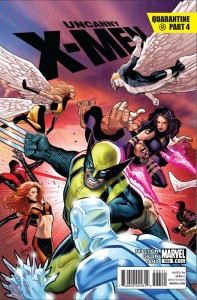 One of the best parts of the X-Men universe is the depth of continuity between the books – they all interact with each other and reference stories as far back as 1963!
One of the best parts of the X-Men universe is the depth of continuity between the books – they all interact with each other and reference stories as far back as 1963!
However, part of what makes them great is also what makes them daunting to start reading from scratch. It might seem like you have to pass a college-level “History of X-Men” course to make sense of any of their ongoing titles.
I’m here to help you. This page is a spoiler-lite summary of all of the most important points of X-Men history you need to enjoy modern issues and events like Avengers vs. X-Men. Use this page as a study-guide to zip through X-Men wikis, or pick up the graphic novels listed at the end of each section to read the stories in full.
- Step 1: History of the X-Men (1963-2000)
- Step 2: Defining the Modern-Day Mutants (2001-2006)
- Step 3: Searching for Hope (2007-2010)
- Step 4: A Schism in the X-Men (2010-2012)
Step 1: History of the X-Men (1963-2000)
While just about every issue of X-Men remains a vital part of the ongoing continuity of mutants in Marvel Comics, many modern plots rely on the same handful of older issues to inform them. If you know the X-Men from other media you can likely skip this step. Otherwise, here are the basics.
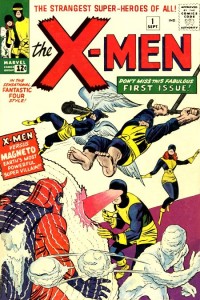
Introducing the X-Men (1963)
The debut issue of X-Men introduces Professor Charles Xavier and the “Original Five” X-Men: Cyclops, Beast, Angel, Iceman, and Jean Grey. Professor X gathered them together at his school in Westchester, NY in order to train them to hone their powers. It also intros their long-time foe: Magneto, who thinks mutants are truly a superior race. He is their primary antagonist for their first year of stories, during which we get to see the team learn to work together.
Issues: X-Men #1-10
Where to read: Read all ten of the original issues in Marvel Masterworks: X-Men, Vol. 1 hardcover or paperback, or grab a bigger B&W chunk of issues with Essential Classic X-Men, Vol. 1. Not a fan of 1960s comics? Check out the modernized version of the story in X-Men: Season One. See Uncanny X-Men #1-141 for more info.
A Second Genesis (1975)
The X-Men went on hiatus starting in 1970 with issue #67, but Marvel took the unusual step of continuing to publish their title featuring reprinted stories. That all changed with Giant-Size X-Men in 1975. It introduced a new team of international X-Men with many familiar favorites: Storm, Colossus, Nightcrawler, Wolverine, and Banshee – plus Thunderbird and Sunspot.
The new team is tasked with retrieving the original five (plus Havok and Polaris) from a deadly island called Krakoa, lead by the only escaped member, Cyclops. This story segues into an often-referenced sequence of events that sees one of the new members die on a mission, and results in Jean Grey piloting a transport from orbit back to Earth. She uses her telekinesis to protect her teammates during re-entry, and though the radiation should have killed her, in the next issues she emerges from the crash as The Phoenix!
Issues: Giant-Size X-Men #1 and X-Men #94-100, with Jean’s re-emergence in #101.
Where to Read: The run through #100 is easily read in Marvel Masterworks: Uncanny X-Men, Vol. 1 hardcover or paperback, as well as in the B&W Essential X-Men, Vol. 1. See Uncanny X-Men #1-141 for more info.
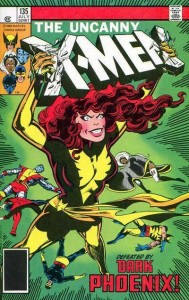 The Dark Phoenix Saga (1980)
The Dark Phoenix Saga (1980)
Frequently voted as one of the best comic stories of all time, it starts innocently enough with the team trying to recruit a new member: Kitty Pryde AKA Shadowcat. However, a competing recruiter has her eyes on young Ms. Pryde – none other than the villainous White Queen, Emma Frost!
Then, when the team comes into conflict with the nefarious Hellfire Club, Jean loses control over her Phoenix powers and persona, and proceeds to wreak havoc in New York City and across the galaxy! Only the X-Men can save her, but even after she gets the Dark Phoenix under control it might not be enough to assuage the avenging Shi’ar Empire.
Issues: X-Men #129-137
Where to read: The Dark Phoenix Saga appears in an older TPB, an over-priced over-sized hardcover with poor binding, or a newer TPB with the same expanded contents. You can also grab the majority of it in Marvel Masterworks: Uncanny X-Men, Vol. 4 hardcover or paperback, or all of it in B&W in Essential X-Men, Vol. 2. See Uncanny X-Men #1-141 for more info.
More Merry Mutants (or: The Villainous Rogue and Gambit)
How did we go from two classes worth of X-Men to many dozens? The answer is that new mutants began to join the team one-at-a-time, in addition to the occasional full class of new recruits.
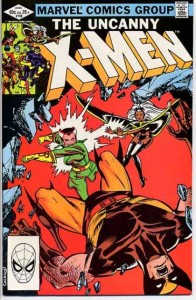 This trend began with Rogue. She is one of the most-beloved X-Men characters, but she didn’t start out that way. She debuted in the pages of The Avengers, wreaking havoc on the team and permanently de-powering one of their marquee members! After that she became an occasional X-Men villain, until foster-mother Mystique dropped her off at the Xavier School for a more permanent stay.
This trend began with Rogue. She is one of the most-beloved X-Men characters, but she didn’t start out that way. She debuted in the pages of The Avengers, wreaking havoc on the team and permanently de-powering one of their marquee members! After that she became an occasional X-Men villain, until foster-mother Mystique dropped her off at the Xavier School for a more permanent stay.
To say the X-Men were less then enthusiastic about their new teammate is an understatement, but over time Rogue became a central player on the team. Rogue’s one-off membership sets the stage for the next group of mutants to call themselves X-Men: Forge, Rachel Summers, Psylocke, Dazzler, Longshot, and Jubilee. The end of this line of new members is another hugely famous example – Gambit, who joined almost a hundred issues after Rogue!
Issues: Rogue debuts in Avengers Annual #10 and joins the team in Uncanny X-Men #171. Others join the team one by one until Gambit completes the trend in Uncanny X-Men #266-267. Psylocke’s joining in Uncanny X-Men #213 is a particularly famous issue, but you may not recognize her – this is before she inherited her ninja body.
Where to read: The best way to catch up on these firsts is We Are X-Men, which specializes in collecting these debut issues – #1, Giant-Size X-Men #1, #129 (Kitty), #171 (Rogue), #200 (Magneto), #213 (Psylocke), #267 (Gambit), & #287 (Bishop), and New X-Men (2001) #116 (Emma Frost)! Gambit’s debut and subsequent stories are conveniently collected in Gambit Classic, Vol. 1. Also of note, the re-debut of Psylocke as a ninja was recently recollected in Psylocke, along with her Utopia-era mini-series.
Optional: The X-Men’s Greatest Hits
There are many, many stories between The Dark Phoenix Saga and the next entry that are still referenced today. Really the entirety of issues #94-280 are permanent cannon to which every subsequent X-Men story makes at least an implied reference.
Here is a quick run down of a few of the greatest hits of that period:
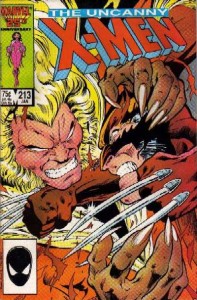 The Brood Saga / New Mutants: The X-Men face a race of space alien bugs that are more than a little inspired by Ridley Scott’s Alien. Meanwhile, back on Earth, Professor X fears the X-Men are dead and assembles a third class of students – The New Mutants. Read it in issues #155-167. See Uncanny X-Men #141-280.
The Brood Saga / New Mutants: The X-Men face a race of space alien bugs that are more than a little inspired by Ridley Scott’s Alien. Meanwhile, back on Earth, Professor X fears the X-Men are dead and assembles a third class of students – The New Mutants. Read it in issues #155-167. See Uncanny X-Men #141-280.
God Loves, Man Kills: This graphic novel was the inspiration for the film X-2. In it, the classic X-Men cast is pitted against charismatic preacher William Stryker, who wants to eliminate the mutant race and is willing to use Professor X to help him get his way. Add a polarizing Magneto to the mix and you have a seminal X-Men story with plenty of shades of gray. See Uncanny X-Men #141-280.
The Birth of X-Factor: The Avengers find a mysterious cocoon radiating energy in the bottom of Jamaica Bay, and what they find inside would rock the X-Men to the core – if only they knew about it. Meanwhile, X-Men misses the birth of his son to Jean Grey lookalike Madelyne Prior. When they have a falling out over his continued commitment to the X-Men, a powerless Storm challenges him to a dual for the team’s leadership. The result of this pair of stories allows for the formation of X-Factor – the original X-Men back with a new purpose. Read it in Avengers #263, Fantastic Four #286, Uncanny X-Men #200-201, and X-Factor #1. See Uncanny X-Men #141-280 and X-Factor.
Mutant Massacre: A team of murderous mutants called The Marauders attack the sewer-bound culture of mutant Morlocks, intent to kill every one of them! Both the X-Men and the newly-formed X-Factor cross over to intervene – and the attack has grace consequences for both teams. See Uncanny X-Men #141-280.
X-Tinction Agenda: A small island nation off the eastern coast of Africa builds a technologically-advanced and prosperous society on the backs of a class of mutant slave-laborers. When Genoshan forces kidnap several X-Men from the mansion, it’s up to the combined might of the X-Men, New Mutants, and X-Factor to rescue them – and remove the corrupt government of Genosha from power. This story isn’t as rivetting a read over twenty years later, but this is far from the last time the island of Genosha would play a major role in an X-Men story. See Uncanny X-Men #141-280.
Magneto and Asteroid M (1991)
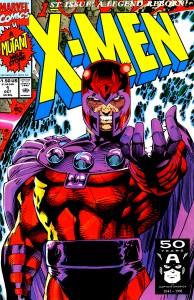 While Magneto has faced off against the X-Men dozens of times, in the 80s he actually joined their side – becoming the headmaster of the Xavier school while Charles was away in space. This arc marked his return to villainy, as well as being the first time the entire modern roster of X-Men fought together in one place at one time – that includes the original five, the remaining Second Genesis crew, and newer members Rogue, Psylocke, Jubilee, and Gambit.
While Magneto has faced off against the X-Men dozens of times, in the 80s he actually joined their side – becoming the headmaster of the Xavier school while Charles was away in space. This arc marked his return to villainy, as well as being the first time the entire modern roster of X-Men fought together in one place at one time – that includes the original five, the remaining Second Genesis crew, and newer members Rogue, Psylocke, Jubilee, and Gambit.
The entire team faces off against Magneto as he plunges the Earth into panic by altering the planet’s electromagnetic function from his home on Asteroid M – which would later play home to more than just Magneto. This might look familiar even if you have never read it, thanks to Jim Lee art that was aped by everything from cartoons to action figures.
Issues: X-Men, Vol. 2 #1-3
Where to read: This arc and the landmark Omega Red introduction that followed are available in hardcover, TPB, newly recolored hardcover, and as part of X-Men: Claremont/Lee Omnibus, Volume 2. If you really enjoy the Asteroid M story and feel as though it ends on a cliffhanger, you should also look into the Fatal Attractions story-arc, which was a sort of sequel.
![]()
That leaves out plenty of classic storylines (X-Cutioner’s Song, Fatal Attractions, Phalanx Covenant, Age of Apocalypse, Onslaught, Rogue Nation, The Twelve, and more!), but those are the aspects of X-Men history that are most frequently referenced today.
![]()
Step 2: Defining the Modern Day Mutants (2001-2006)
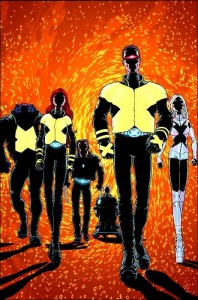
While a lot of important X-Men events occurred in the 80s and 90s, you can skip the majority of them thanks to a quick succession of major stories in the early 00s that altered the status quo of the team.
New X-Men by Grant Morrison (2001-2004)
After the success of the first X-Men film in 2000, Grant Morrison was charged with modernizing the spandex clad team of mutants to be more in line with the cinematic version. He did more than that – forever changing the model of the team by adding Emma Frost as a permanent member, and altering the dynamics of longtime characters Cyclops, Jean Grey, and Beast. He also radically shifted how mutant culture worked within the Marvel Universe – on one hand, cutting their population by millions, but on the other showing how mutants could by considered avant guard. His run ends with a massive blowout in NYC, which has a lasting effect on Jean Grey but gets retconned for Magneto just a few months later.
Issues: New X-Men #114-156
Where to read: The two key arcs of Morrison’s run are “E for Extinction” and “Riot at Xavier’s”, though you should also read “Planet X” for the climax. However, he truly shook the X-Men paradigm in every issue. For complete collection info, see my New X-Men page.
Astonishing X-Men by Joss Whedon (2004-2008)
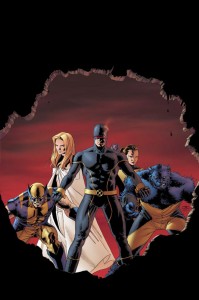
On the heels of Morrison’s run, the newly-established core of the X-Men was taken over by Joss Whedon. He further cemented the modern-day team as being built around a nucleus of Cyclops, Wolverine, Emma Frost, and Beast, and reintroduced Kitty Pryde to the mix after years of only sporadic appearances. This run is referred to as “continuity free” – even though it fits in with other comic books, you can read all of it with no outside knowledge (even though House of M occurs in the middle of it!)
Issues: Astonishing X-Men #1-24 & Giant-Size
Where to read: Whedon’s introductory arc “Gifted” is the must-read here, but the entire series is easy to acquire and fun to read. For complete collection info, see my Astonishing X-Men page.
Optional: The New Age by Chris Claremont (2004-2006)
Chris Claremont is the father of modern-day X-Men, having written the flagship title from 1975-1991. He has made a few return engagements, but this is the most notable. While Whedon works with the core of the X-Men, Claremont reestablishes a core “away team,” brings X-23 into the X-Men fold, and deals with ongoing ramifications of the Phoenix Force.
Issues: Uncanny X-Men #444-474
Where to read: Visit the New Age section of my Uncanny X-men page for collection info.
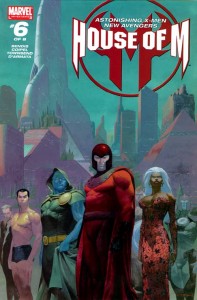 House of M by Brian Bendis (2005)
House of M by Brian Bendis (2005)
This is a tricky one to explain to new and returning fans. Basically, you don’t need to read this event at all, if you don’t want to. It is set in an alternative reality where mutants are the dominant race. The important part is how we got from that reality back to Marvel’s main continuity. To do that, The Scarlet Witch made a major change in the status quo. I won’t spoil the huge twist for you, but as a result mutants become more of an endangered species than ever. Civil War occurs shortly after this, but the X-Men are too pre-occupied to participate (and, technically, under house arrest at the mansion).
Issues: House of M #1-8 & X-Men, Vol. 2 #177-181
Where to read: House of M is conveniently collected in a single book in hardcover and paperback. To understand the ramifications better, you should read a “Decimation” storyline from X-Men, Vol. 2 – it’s collected in X-Men: The Day After. You will see other House of M collections – they represent other character’s forays into the alternate reality. None are essential (not even Uncanny!), but if you are a Wolverine fan you should read his portion – as it results in a major change in status quo for his character.
![]()
Now you understand the core of the present days X-teams, as well as the environment for mutants around the world. You could leap right from here to the present day, but you would still be missing some major elements about where the X-Men live, how they operate, and the one small semblance of hope in the grim outlook for the mutant race.
![]()
Step 3: Searching for Hope (2007-2010)
After the events of House of M the entire line of X-Men comic books became more thematically cohesive, which generated a lot of notable stories. A lot of them are worth reading, but this section represents the consolidated path to understanding present events and characters.
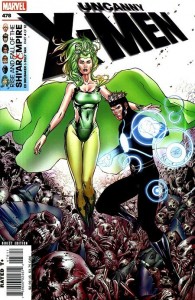 Optional: Deadly Genesis & The Rise and Fall of the Shi’ar Empire by Ed Brubaker (2006-2007)
Optional: Deadly Genesis & The Rise and Fall of the Shi’ar Empire by Ed Brubaker (2006-2007)
This two-story sequence is primarily for fans of Cyclops, Professor X, and the pair of Havok and Polaris. In Deadly Genesis we learn about a long-kept secret by Professor Xavier that will change the way you think about him (and the way he is treated by the team). As a result, a group of X-Men head to space to try to apprehend a new, mega-powerful mutant with ties to Cyclops. This results in Havok and Polaris leaving the X-Men books for over half a decade, though their story is continued in the fantastic War of Kings saga.
Issues: X-Men: Deadly Genesis #1-6 & Uncanny X-Men #475-486
Where to read: There are just two volumes to pick up here – Deadly Genesis and Uncanny X-Men: The Rise and Fall of the Shi’ar Empire.
Want more? If you love the morally gray Professor X, you should pick up X-Men: Original Sin, which comes after Messiah Complex, below. If you enjoy Havok and Polaris in space, but the sequence of X-Men: Emperor Vulcan, Road to War of Kings, and oversized hardcover, or as War of Kings and War of Kings: Warriors paperbacks.
Messiah Complex (2008)
Once you understand the ramifications of House of M, the next step is this epic multi-title crossover. With the emergence of new mutants seemingly halted across the globe, when Cerebro registers a mutant birth it’s a big deal. Unfortunately, it’s also major news to some of the X-Men’s deadliest foes – the anti-mutant Purifiers and Mr. Sinister’s Marauders. It is impossible to overstate the importance of this event – it is the start of over three years of major plot points.
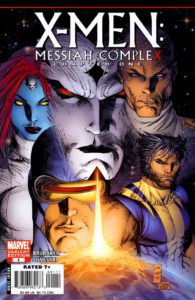
Issues: X-Men: Messiah CompleX One-Shot, Uncanny X-Men #492-494, X-Men #205-207, New X-Men #44-46, X-Factor #25-27
Where to read: Grab the X-Men: Messiah Complex trade paperback.
Want more? To add some context, you may also be interested in Endangered Species, which helps explain the lengths the X-Men have gone to to try to jump start their gene pool.
Optional: Force and Hope (2008-2010)
Two new series branch from Messiah Complex – X-Force, Vol. 3 and Cable, Vol. 3. You don’t have to read either – their events are tidily recapped by interactions in Uncanny X-Men. However, they are both strong, and answer some major questions you might have had at the end of Messiah Complex.
Issues: X-Force #1-25 & Cable #1-25
Where to read: If you want to see how Cyclops responds to the threats to his newly-endangered race, move forward to a Wolverine-led X-Force. This is especially important if you care a lot about Angel and X-23. If you want to see where Cable and Bishop wind up after the shocking end of Messiah Complex, see Cable’s ongoing series. If you like both, then make sure to read their crossover, Messiah War.
Manifest Destiny (2008)
In the wake of Messiah Complex Cyclops finds himself the commander-in-chief of the mutant race, and he decided that part of their survival strategy should be relocating to a new city – San Francisco. This arc sets up the X-Men uneasy truce with the city of SF, and helps to cement Pixie, one of the newest mutants to become a leading character.
Issues: Uncanny X-Men #500-503
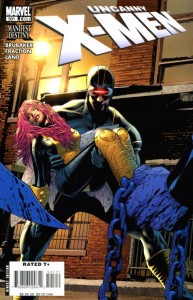
Where to read: Get Uncanny X-Men: Manifest Destiny, which has a pinkish painted cover.
Want more? For some extra context, you can also grab the proceeding X-Men: Divided We Stand or the accompanying short stories in X-Men: Manifest Destiny. Also the X-Men: Secret Invasion fits in here, which definitely has some lasting ramifications for the ethical positions of Cyclops and Beast.
Optional: Utopia & Nation X (2009-2010)
As a result of Secret Invasion, Normal Osborn (the original Green Goblin) finds himself leading a team of government-endorsed former villains – including one surprisingly close relation to a longtime X-Men. When the team tries to escort the X-Men out of SanFran sparks fly, and Cyclops doubles down to an even more-entrenched position off the coast of the city.
With the majority of the mutant race occupying a single island nation, things are bound to get tense in ways we’ve never seen before. This run of Uncanny X-Men issues sees some major shake-ups and answers a slew of the most frequent questions from new fans: How does leadership effect Cyclops? How does Utopia even float, let alone sustain a population Why are Namor and Magneto now X-Men? Where did Kitty come back from? Who is this gang of scientists following the team around? Who are all those young mutants in the background of panels?
Issues: Utopia: Dark Avengers #7-8, Dark Avengers/Uncanny X-Men: Exodus & Utopia, Uncanny X-Men #513-514, and X-Men Legacy #226-227. Nation X: Uncanny X-Men #515-522.
Where to read: Utopia is part of Marvel’s Dark Reign, and is available as Uncanny X-Men / Dark Avengers: Utopia hardcover and paperback. Uncanny X-Men: Nation X hardcover and TPB handily collects these self-contained issues, plus an anthology series of the same name.
Want More? This reintroduces a very different Rogue into the mix, and if you want the background on that you should read X-Men Legacy: Salvage. For more on Dark Avengers’ Wolverine, check out Dark Wolverine: The Prince. If you dig Nation X, a good companion is X-Men Legacy: Emplate.
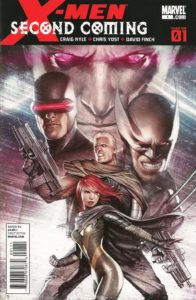 Second Coming
Second Coming
Remember all of those major plot points that began in Messiah Complex? They all take a major next step in this cinematic crossover, which addresses the only new mutant born since House of M, exposes X-Force to the X-Men at large, and sees the Utopia island under heavy siege by unrelenting foes. While Second Coming doesn’t change the status quo quite as much as Complex, it includes the death or dismemberment of several major characters, introduces tension that will eventually explode into Schism, and adds a very important new character to the ranks of the present-day X-Men.
Issues: Second Coming #1-2, Uncanny X-Men #523-525; New Mutants #12-14, X-Men Legacy #235-237, X-Force #26-28
Where to read: Pick up X-Men: Second Coming hardcover or TPB.
Want more? There is a companion volume called Second Coming: Revelations that includes some side-adventures related to the crossover, but it’s purely optional. The entire X-Force series discussed above acts as background to the villains in this story.
![]()
Now you know about the endangered status of the mutant race, who Hope is and how she went from newborn to teenager, and how Cyclops can be seen by some as a not-so-benevolent dictator. This puts you in a great position to read brand new comics, but you’re still missing out on one of the biggest recent developments in X-Men – which explains why there are two sides of the X-Men as of the beginning of 2012.
![]()
Step 4: A Schism in the X-Men (2010-Present)
Optional: Meet Generation Hope
The introduction of Hope into the present-day lineup of X-Men has the immediate effect of spurring the emergence of new mutant signatures around the globe. The team rushes to meet each new mutant in turn, although some meetings turn out better than others. In the end, Hope winds up with her own team of inexperienced mutants, all with an inexplicable connection to her. In the long run they aren’t so important, but this is a major step in Hope’s present day story.
Issues: Uncanny X-Men #526-529
Where to read: Uncanny X-Men: Birth of Generation Hope.
Want More? If you fall in love with the characters, you’ll want to follow up with Generation Hope: The Future’s a Four-Letter Word
Optional: Age of X
One day Utopia awakes to find the whole world has changed, and the X-Men along with it. In this alternate-reality tale, Magneto is the master of the mutant race, and Rogue is a ostracized reaper of memories who ensures no mutant ever truly dies. Yet, there is more to this alternate world than initially meets the eye, and it has a tangible impact on the real world of X-Men – especially when it comes to characters who will go on to be featured in X-Men Legacy.
Issues: Age of X: Alpha, New Mutants #22-24, X-Men Legacy #245-247, and Age of X: Universe 1-2.
Where to read: Age of X is collected in a single volume in hardcover or TPB.
Want More? To understand why it occurred, you’ll want to read the outstanding Fall of the New Mutants, which bridges from Second Coming to Age of X and sets up the circumstances of this crossover. For an epilogue, check out X-Men Legacy: Aftermath, which is a much more personal collection of stories from before and after the event (even though they do include some punching).
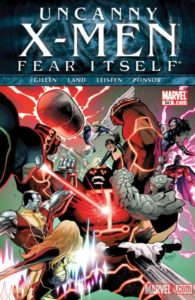 Fear Itself: X-Men vs. The Juggernaut
Fear Itself: X-Men vs. The Juggernaut
The X-Men have fought Juggernaut many, many times – but this one is different. Here, Cain Marko is imbued not only with the power of Cyttorak, but also the deadly power of the villain behind the Fear Itself event. If the X-Men thought he was unstoppable before, now the word has a whole new meaning! The only way for the team to put a stop to Juggernaut’s rampage is for one of member to sacrifice their humanity – and you might be surprised at who, or how that occurs. The result is a huge piece of the next step in the X-Men’s story.
Issues: Uncanny X-Men #540-543
Where to read: These issues are contained in a single volume of Fear Itself: Uncanny X-Men.
Want More? You may want to read the main Fear Itself hardcover, though it is not essential. If you want to understand Illyana, why she’s a prisoner, and why everyone seems to be so upset at her, once again I must recommend the riveting Fall of the New Mutants, and maybe even the first volume of the new New Mutants series for some further background.
Optional: Wolverine Unleashed
Wolverine’s solo adventures don’t frequent feedback too strongly into the main X-Men continuity, but this is a major exception. Wolverine is trapped in his own mind as his possessed body makes a deadly strike on the X-Men on Utopia. When he regains control of his body, he’s hell-bent on getting his revenge on the people responsible – but Wolverine’s revenge cuts both ways as we learn more about the group who set him up in the first place.
Issues: Wolverine, Vol. 4 #6-14
Where to read: This story is covered in two volumes penned by Jason Aaron – Wolverine vs. The X-Men and Wolverine’s Revenge. The outcome has a direct result on his actions in Schism.
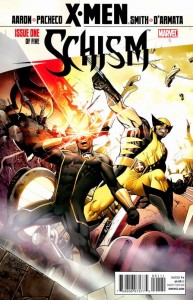 Schism
Schism
When a new non-mutant player decides to take aim at the X-Men, the team finds itself struggling against the twin threats of public opinion and fleets of sentinels. However, it’s a personal conflict that fells the team, with Cyclops and Wolverine taking different sides of a heated philosophical argument about the survival of the mutant race.
Issues: X-Men: Schism #1-5, Generation Hope #11-12, X-Men: Regenesis, Uncanny X-Men #544
Where to read: First, let me be clear – this story is not as important as everyone makes it out to be and it has some major detractors (myself include). All you need to know is Cyclops and Wolverine are both stubborn, disagree over how young mutants should be treated, and are both largely mischaracterized here. Unfortunately, the mischaracterization becomes the new status quo, so you might want to read it via the hardcover. This event is accompanied by Generation Hope: Schism, which includes issues that ran alongside the Schism event and provide greater insight into the young girl at its center (hint: it’s not Hope). Uncanny X-Men #544 is collected in the Fear Itself volume, above.
Optional: The Dark Angel Saga
While Schism boiled over on Utopia, another long-simmering plot came to a head in the pages of Uncanny X-Force. Wolverine’s new covert team had a mission to put a pre-emptive end to the reemergence of Apocalypse, but their teammate Angel winds up being an even bigger threat. This critically acclaimed story-line relies on a lot of X-Men history not included in this guide, but it does a great job of explaining it at every step.
Issues: Uncanny X-Force #8-18
Where to read: The story is contained in two volumes of Uncanny X-Force – Dark Angel Saga Part 1 and Part 2.
Want More? I highly recommend reading the introductory arc of the title – The Apocalypse Solution – for relevant background and a simply incredible story.
A New Pair of Flagships
After Schism, the old flagship book Uncanny X-Men splits into two separate books on different sides of the schism. Cyclops continues to command a Utopia-based team in Uncanny X-Men, Vol. 2. Meanwhile, Wolverine takes his side back to New York in Wolverine and the X-Men, where he builds a new school. Uncanny has a super-series, villain-focused vibe. WatX is ultra-cartoonish, from the threats the school faces to the unruly artwork.
Where to read:
Check out Uncanny X-Men by Kieron Gillen Volume 1 and Volume 2 for a rather villainous look at the X-Men – both due to the team members and the way the issues are written. If you plan to read Dark Angel, do so prior to Volume 2.
For Wolverine’s side of the story, see Wolverine and the X-Men by Jason Aaron Volume 1 and Volume 2. If it doesn’t make sense to you, don’t worry – for every whimsical set-piece that has a clear explanation, there is another that is totally made up anew.
![]()
Congratulations – you have arrived at Avengers vs. X-Men fully informed about all that’s gone down in recent X-Men history, and are ready to jump into Marvel Now!
![]()
Back to Collecting X-Men
[…] about additional X-Men series and reading order, I recommend checking out Crushing Krisis’ Become an Instant X-Men Expert. […]